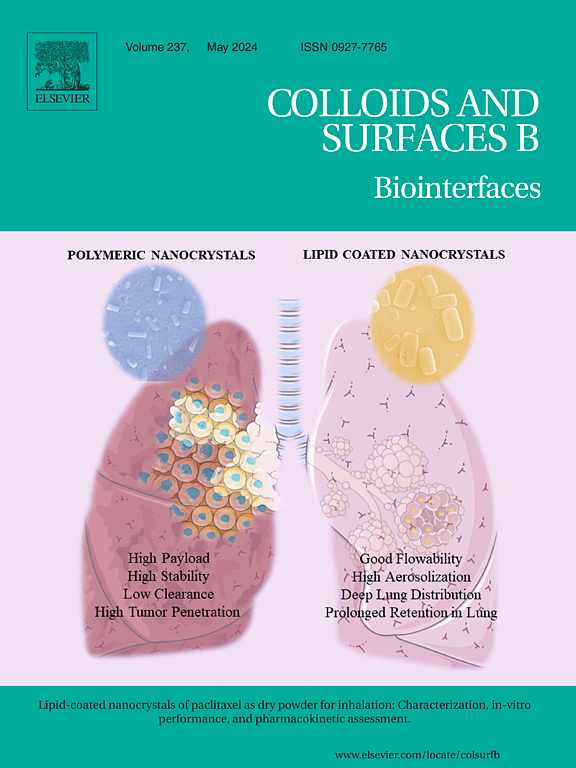Modeling bacterial adhesion onto nanostructured silicon carbide using a new physicochemical approach: Statistical physics analysis
IF 5.6
2区 医学
Q1 BIOPHYSICS
引用次数: 0
Abstract
Bacterial adhesion on ceramic materials is a crucial phenomenon worldwide, particularly in water nanofiltration. The extended DLVO theory is currently the physicochemical approach that can be used to investigate on the adhesion process. However, this study proposes the statistical physics formalism as an alternative theoretical approach to describe, qualitatively and quantitatively, the adhesion of Pseudomonas putida (P.putida) onto the micrometric silicon carbide (μmSiC) and its nanostructures: nanofibers (NFSiC) and nanorods (NRSiC). The modelling of experimental adsorption isotherms of this bacteria onto the investigated materials at different pH (3, 6.8 and 9) allowed both the stereographic and energetic characterization of the bacterial adsorption process. According to Hill model, P.putida adsorption onto NFSiC and NRSiC is found to be multicellular, perpendicular orientation to the surface and it depends on pH medium. However, this bacteria adhere onto µmSiC surface in parallel way for all pH values. Also, the adsorption capacity of P.putida onto NRSiC and NFSiC is higher and strongly affected by the pH solution, than on µmSiC surface. The quantification of adhesion energy of one bacterium (> −31 x10−23 kJ) and of molar adsorption energy (> −187 kJ/mol) indicates that P.putida adhesion on all nanomaterials and for all pH values is a strong chemical adsorption. At macroscopic scale, the thermodynamic analysis has shown that adhesion process is exothermic and its spontaneity is significantly affected by pH medium. Finally the calculation of the internal energy confirmed that P.putida adhesion was stronger on SiC nanostructures (∼95 kT) than on µmSiC (∼80 kT).
用一种新的物理化学方法模拟细菌粘附在纳米碳化硅上:统计物理分析
细菌在陶瓷材料上的粘附是世界范围内的重要现象,特别是在水纳滤中。扩展的DLVO理论是目前可以用来研究粘附过程的物理化学方法。然而,本研究提出了统计物理形式化作为定性和定量描述恶臭假单胞菌(P.putida)在微米碳化硅(μmSiC)及其纳米结构:纳米纤维(NFSiC)和纳米棒(NRSiC)上的粘附的替代理论方法。该细菌在不同pH值(3、6.8和9)下对所研究材料的实验吸附等温线进行建模,从而可以对细菌的吸附过程进行立体和能量表征。根据Hill模型,发现恶臭杆菌在NFSiC和NRSiC上的吸附是多细胞的,与表面垂直,取决于pH介质。然而,这种细菌在所有pH值下都以平行的方式附着在μ mSiC表面。此外,恶臭杆菌对NRSiC和NFSiC的吸附量比在µmSiC表面的吸附量高,且受pH溶液的影响较大。细菌黏附能的定量分析(>;- 31 x10 - 23 kJ)和摩尔吸附能(>;−187 kJ/mol)表明P.putida对所有纳米材料和所有pH值都具有很强的化学吸附作用。在宏观尺度上,热力学分析表明,黏附过程为放热过程,黏附过程的自发性受pH介质的显著影响。内能的计算证实了P.putida在SiC纳米结构(~ 95 kT)上的粘附比在µmSiC (~ 80 kT)上的粘附更强。
本文章由计算机程序翻译,如有差异,请以英文原文为准。
求助全文
约1分钟内获得全文
求助全文
来源期刊

Colloids and Surfaces B: Biointerfaces
生物-材料科学:生物材料
CiteScore
11.10
自引率
3.40%
发文量
730
审稿时长
42 days
期刊介绍:
Colloids and Surfaces B: Biointerfaces is an international journal devoted to fundamental and applied research on colloid and interfacial phenomena in relation to systems of biological origin, having particular relevance to the medical, pharmaceutical, biotechnological, food and cosmetic fields.
Submissions that: (1) deal solely with biological phenomena and do not describe the physico-chemical or colloid-chemical background and/or mechanism of the phenomena, and (2) deal solely with colloid/interfacial phenomena and do not have appropriate biological content or relevance, are outside the scope of the journal and will not be considered for publication.
The journal publishes regular research papers, reviews, short communications and invited perspective articles, called BioInterface Perspectives. The BioInterface Perspective provide researchers the opportunity to review their own work, as well as provide insight into the work of others that inspired and influenced the author. Regular articles should have a maximum total length of 6,000 words. In addition, a (combined) maximum of 8 normal-sized figures and/or tables is allowed (so for instance 3 tables and 5 figures). For multiple-panel figures each set of two panels equates to one figure. Short communications should not exceed half of the above. It is required to give on the article cover page a short statistical summary of the article listing the total number of words and tables/figures.
 求助内容:
求助内容: 应助结果提醒方式:
应助结果提醒方式:


